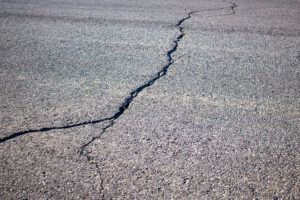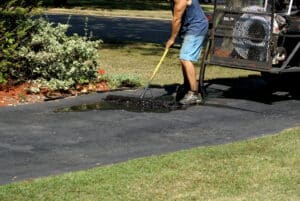Asphalt is an essential construction material applied to various parts of the property like driveways, parking lots, roads, or streets. However, unlike other materials, its durability is affected by the harsh outdoor environment and public use. Therefore, asphalt surfaces are prone to cracks. Cracks signal the beginning of more significant problems. Though cracks can be a normal part of asphalt aging, they often signal the beginning of more significant problems underneath the surface.
Ideally, before you embark on asphalt crack repair, it’s advisable to investigate the cause of the damage. Identifying the problem first is an objective approach that reduces the possibility of re-occurrence. So, what causes cracked pavements, broken asphalt, or cracks in general?
Causes of Asphalt Cracks
The shape or impression of the damage is one of the ways you can use to identify the cause of the crack. For instance, one of the common types of cracks resembles alligator markings. If you identify these types of lines and patches, it indicates that the pavement is overloaded. A property owner who’s knowledgeable about these matters can discuss with the contractor using an objective approach instead of merely looking for a discount.
Nonetheless, below are some of the general causes of cracks:
Poor Drainage
If your property has a defective drainage system, the run-off from elevated areas will most likely terminate in the driveways and paths. Over time, run-off affects the asphalt surface and sub-base.
Minimal Edge Support
Drive edges can crack into a curved sickle shape and eventually expose deeper layers. It’s caused by inadequate reinforcement in the borders and water seeping from beneath. Edge cracking can also indicate minimal edge support, resulting from soil drying and insufficient lateral support.
Temperature Changes
Sudden temperature changes, for example, unexpected spring thaws or scorching days, can cause cracks. The cracks form as a result of a weakened sublayer or over-expansion of the asphalt layer. Traverse cracks develop a perpendicular line to the centerline due to sudden temperature changes.
Poor Layering Process
A defective layering process can cause stripping, raveling, or block cracking. You can identify these types of cracks when asphalt separates from the other layers. Insufficient moisture during the original application of asphalt also contributes to these types of cracks. In addition, extreme temperatures can hinder the expansion or contraction of the asphalt binder, eventually leading to cracks. You may also note crescent-shaped cracks resulting from non-adhesive materials such as water or dirt between the layers. These unwanted items weaken the bond, culminating in cracks.
Read More: Why Asphalt Cracks Form
Benefits of a Timely Asphalt Crack Sealing & Repair
As a property manager, it pays to observe when damage occurs and prioritize timely asphalt crack repair. A delay may lead to the continued expansion of the crack that is expensive to repair in the long run.
Here’s why it’s crucial to conduct timely crack sealing:
- Checks Further Crack Expansion: A neglected crack tends to expand as time progresses. A small crack can develop into a larger crack that permeates other layers. Eventually, a tiny crack can cut across an entire pavement, driveway, or parking lot.
- Eliminates the Need For Asphalt Removal: Asphalt crack sealing prevents extensive damage whose only solution is complete removal. Unfortunately, asphalt removal is expensive and causes vast disruption to residents as compared to conducting more limited repairs.
- An Extended Asphalt’s Lifespan: Periodic asphalt crack sealing e.g. every two years, will work to elongate the lifespan of your driveway or parking lot. With consistent and timely maintenance, the asphalt can serve as long as 20 years.
Read More: What is Crack Sealing?: A Guide for Property Managers
How to Repair Asphalt Cracks
Crack sealing materials are vital in asphalt repair. Some of the vital qualities in the asphalt patching material include good adhesion, elasticity, and deters softening. It should also be compatible with the material in the driveway and resist cracking or aging. You can use asphalt emulsion or asphalt cement for crack filling. On the other hand, crack sealing requires rubberized asphalt or asphalt rubber.
Here are a few prerequisite steps:
- Preparation: Preparation can involve cleaning, removing extraneous materials, and slightly expanding the cuts if need be. Vertical spindle or rotary impact routers are some of the tools you can use to route the cracks. After routing, clean the cracks or potholes using high-pressure air, hot air blasting, or high-pressure water. Cleaning is an essential process that ensures sealants adhere to the gaps.
- Crack Sealing: After preparing the affected areas, sealing them with asphalt is the next step. You can either use a truck-mounted pressure machine, power pots, or hand wands. Irrespective of equipment in use, ensure the asphalt temperatures are between 50-90 degrees to maintain uniformity and prevent further cracks. It’s advisable to apply rubberized asphalt emulsion crack filler at the bottom to prevent bubbles, which is a weak spot.
- Surface Patching: Surface patching is an alternative method used to fill temporary patches. The first step is to mill the affected area to gorge out unwanted materials. Milling is a crucial process that ties the new patch to the pavement. Other alternative methods include spray-injection patching, infrared heater patching, or cold weather emergency patching.
Read More: Cracked Asphalt: When to Seal vs. When to Repair
Crack Repair and Maintenance: Tips & Reminders
- Plan to seal your asphalt at least every three years with a seal coat. The seal acts as a sunscreen that prevents oxidation and water penetration.
- Always give a clear description of what the job entails before inviting bids. For example, a contractor may bid on sealing, whereas the job entails pothole repair, crack filling, and sealing.
- Screen the type of vehicles stepping on the asphalt path, for example, garbage trucks and heavy machinery. If need be, create a directed vehicle path for heavy machines to minimize asphalt damage to one route.
- Prioritize timely asphalt maintenance; minor and curable issues develop into complex and expensive problems quickly. For example, if you fail to shield the asphalt, oxidation may occur, leading to cracks.
Try Our Asphalt Repair Services
The condition of driveways or pavements reflects the level of a property’s management. Therefore, it’s crucial to make timely asphalt repairs, using the proper procedure, and using the right contractor. Superior Asphalt LC is the right partner in all your asphalt needs. We offer crack sealing, seal coating, repair, and parking lot striping. Contact us to request a quote.
Related Articles:




